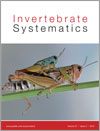IS12031Cryptic species of Nereididae (Annelida : Polychaeta) on Australian coral reefs
Recently, new marine invertebrate species have been discovered based on combined molecular and morphological differences. Using this dual approach, we found eight species (including four new to science) in one family of polychaete worms from Australian coral reefs; only three were indicated using morphology alone. This study supports the value of using a combined morphological–molecular approach and suggests the number of polychaete species is higher than currently thought.




